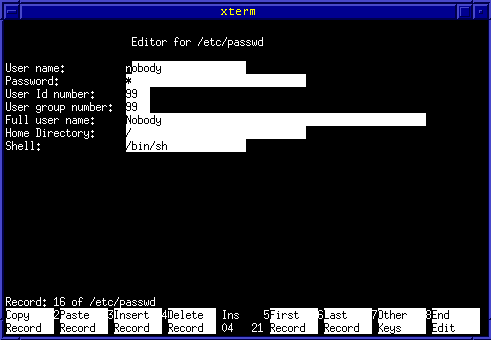
SCRMGR is a curses-based (text screen or 'console') screen manager and data entry system. It makes heavy use of "softkey labels" and "softkeys" (a.k.a. function keys F1-F10) to guide the user.
The initial inspiration for this was:
Why put it out now when everyone is using GUIs? Well, I was going to ship it out under GPL several years ago but I wanted to shake out the last bugs. It seems that somehow I never got around to that and somehow never shipped it. Better late than never - well I hope someone else finds this useful! I ran into someone at the local LUG who only runs text console - doesn't run X at all - so maybe there is still an audience out there! He was under 25 years old, too!
There were also Xaw and Openview versions of this but I have not used them for some time now, finding the curses user interface adequate for the simple applications. Tk/tcl would be a better bet if you really want a true GUI. I wrote a version of that too - I called it datatool - but it appears to be broken. If I can get it up and running again, I'll post it on my homepage.
It is quite possible that SCRMGR could be interfaced to mysql or some other true database system instead of using flat files but I have not tried that yet.
Oh yes - nearly forgot. This whole thing also ran on MSDOS and could read and write the same datafiles (it converts Unix<->MSDOS automatically). For a long time, I had to use MSDOS at work and this was how I could keep one set of datafiles at home, at work and on the road in sync - one address book everywhere. I don't use any MS products now but I do have a Psion which can read these flat files into its address book.
SCRMGR also once ran on SunOS under XView/OpenView using a tool called xctool instead of xterm. This gave it a nice GUI.
I doubt that the MSDOS or SunOS ports will compile using the supplied makefiles but it shouldn't be too hard to get them going. I no longer have access to MSDOS at all and no current interest in using this on Sun so I cannot support them. If anyone else does, then I'd be willing to include your patches.
An interesting little twist (to me, anyway) was using SCRMGR to build its own screens, menus, softkey labels and other facilities. An exercise in bootstrapping itself. The first, primitive version was build with a hand-coded .dat file. This was then used to develop better versions. Cute. The present 'make install' process still uses this approach compiling sm2c first and using that to process various screen files for use in the system.

Copyright© 1997-2002 Bob Hepple. All rights reserved.'